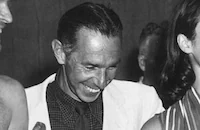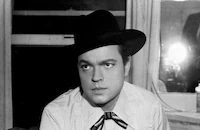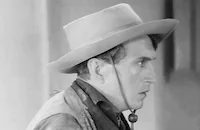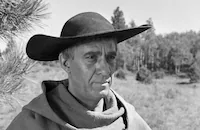Man in the Shadow
Brief Synopsis
Cast & Crew
Jack Arnold
Jeff Chandler
Orson Welles
Colleen Miller
Ben Alexander
Barbara Lawrence
Film Details
Technical Specs

Synopsis
When Mexican-American laborer Jesus Cisneros witnesses his fellow brasero, Juan Martin, beaten to death by foreman Ed Yates in the toolshed of Virgil Renchler's Golden Empire ranch, he timidly reports the murder to sheriff Ben Sadler. At first reluctant to confront Renchler, the most powerful man in the county, Ben finally decides that it is his duty to investigate the charges, even though his deputy, Ab Begley, tries to dissuade him. After ascertaining that Cisneros will seek refuge at his friend Aiken Clay's ranch, Ben drives to the Golden Empire to question Renchler. Ben is met with hostility by the arrogant Renchler, who belittles his concern for a "wetback" and implies that the sheriff's job will be in jeopardy if Ben continues his investigation. After Ben leaves, Yates admits to Renchler that he killed Martin, and Renchler then phones Herb Parker, the county commissioner. Soon after, Chet Huneker, an employee of the Golden Empire, comes to Ben's office and claims that he hit Martin with his car. At the ranch, meanwhile, Skippy Renchler, Virgil's attractive young daughter, questions her father about the sheriff's visit and recalls hearing a blood-curdling scream the previous night. After declaring that she was only dreaming, Renchler orders Skippy to her room and posts a guard outside her door. Defying her father, Skippy slips out the window. At the office of coroner Jake Kelley, Cisneros, meanwhile, identifies Martin's body. When Ben tells Cisneros Chet's story about hitting Martin with his car, Cisneros claims that Chet helped Yates beat Martin to death. After imploring Ben to drop his investigation, Kelley phones Renchler to apprise him of the situation. Upon returning to his office, Ben finds Skippy waiting. When she learns of Martin's death, Skippy asserts that Yates killed Martin because he was jealous of his friendship with her and reveals that she heard a man's scream on the night of the murder. Their conversation is interrupted by Herb, who demands that Ben immediately cease his investigation. Ignoring Herb's threats, Ben obtains a warrant to search the Renchler ranch. At the ranch, Ben goes directly to the tool room, where he finds a patch of blood embedded on a board. As Ben slices the blood from the board, Yates, outside, loosens the lugs on the wheel of the sheriff's car. While driving home, Ben's car wheel falls off, but he is thrown from the vehicle before it crashes into a tree. Upon regaining consciousness, Ben is driven back to town by a passing motorist. There, he finds a drunken Ab, who admits to telling Renchler that Cisneros is at the Clay ranch. Realizing that Cisneros is in danger, Ben speeds to the ranch but arrives too late, for Cisneros has been mortally wounded. At home, Ben receives threatening phone calls, and a rock is hurled through his window. As his wife Helen pleads with him to drop his investigation, Herb, Kelley and the other town officials meet to force Ben from office. When an anonymous caller promises to divulge the truth about the murders if Ben will agree to meet at a deserted shack on the outskirts of town, Ben drives off to the meeting despite the warning of his only ally, barber Tony Santoro. At the shack, Yates and Chet beat Ben unconscious, tie him to the back of their truck and drag him through the town streets as they drunkenly shoot out the shop windows. After Ben is freed and bandaged, he wrathfully pulls a rifle from the gun rack in the sheriff's office, rips off his badge, denounces the town and vows to bring Renchler to justice. Joining Ben on his quest, Clay crashes his truck through Renchler's gate. When Ben proclaims that he is taking Renchler into custody, Renchler unleashes his vicious watchdog on the sheriff, and Chet hurls a knife into Clay's chest. Just as Renchler and his thugs are about to silence Ben forever, the townsfolk arrive, guns in hand. After a violent skirmish, Ab arrests Renchler and his men and then returns the sheriff's badge to Ben.

Director

Jack Arnold
Cast

Jeff Chandler

Orson Welles
Colleen Miller
Ben Alexander

Barbara Lawrence
John Larch

James Gleason

Royal Dano

Paul Fix
Leo Gordon

Martin Garralaga
Mario Siletti
Charles Horvath
William Schallert
Joseph J. Greene
Forrest Lewis
Harry Harvey Sr.
Joe Schneider
Mort Mills
Crew
Arthur E. Arling
John P. Austin
Jim Bean
Leslie I. Carey
Haile Chase
Gene L. Coon
Edward Curtiss
Russell A. Gausman
Joseph Gershenson
Alexander Golitzen
Joe Lapis
David Silver
Alfred Sweeney
Bill Thomas
Al Todd
Bud Westmore
Albert Zugsmith

Film Details
Technical Specs

Articles
Man in the Shadow
Directed by Jack Arnold, Man in the Shadow is a barely disguised allegory of Fascism and corruption on the range that focuses on an earnest sheriff investigating the death of a Mexican laborer who was beaten to death. The trail of evidence leads to the sprawling ranch of Virgil Renchler (Orson Welles), an all-powerful land baron whose hold over the local citizenry creates an insurmountable obstacle in the sheriff's search for the murderer.
In Orson Welles's prolific but frustrated career, Man in the Shadow is significant for two reasons, the first being the fact that it's the ONLY Western Welles ever made. But the more important reason is that the film allowed him to work closely with the producer, Albert Zugsmith, who would give him his first Hollywood directorial assignment in years, Touch of Evil (1958).
In Kings of the Bs, edited by Todd McCarthy and Charles Flynn, Zugsmith recalled the casting of Man in the Shadow: "Jeff Chandler played the sheriff, and we had a new girl under contract, Colleen Miller, a beautiful girl, as the female lead. We were trying to cast the heavy, the girl's father, the rich rancher who oppresses the Mexicans, and so forth. We're pretty much sold on Robert Middleton who did such a great job for me before [in Douglas Sirk's The Tarnished Angels, 1958]. So I got a call from the William Morris office. Evidently they knew the part was open, and Jack Baur asked me, "How would you like Orson Welles to play the heavy?" "You're kidding," I said. He had been out of this country for some time. He was back, he needed $60,000 very badly for taxes, and he'd play the heavy. "Has he read the script?" I said. "I don't think so. But he's gotta pay his taxes, or he'll be in big trouble."
Welles had just experienced another career disappointment when he agreed to star in Man in the Shadow (the working title was Pay the Devil). He had been negotiating with MGM to direct Charles Lederer's screenplay for Tip on a Dead Jockey (1957), based on Irwin Shaw's novel, but the deal fell through. Instead the project went to Richard Thorpe (who would later direct Welles in The Tartars, 1961). Welles took the news in stride, however, and showed up on the set of Man in the Shadow full of enthusiasm - and with a lot of suggestions. In fact, he was carrying a handful of pages and announced to the cast and crew, "You'll be interested to see the changes for today!" A conference with Zugsmith was immediately scheduled and the producer quickly realized that Welles's script changes were indeed an improvement. Of course, this was just the beginning of a daily rewrite ritual that would completely unnerve the other actors.
Zugsmith realized he'd have a mutiny on his hands if he didn't intervene so he took Welles aside and told him that his changes were a "Great improvement. Of course, you'd be doing the actors and myself a great favor if we could get these rewrites that obviously you're going to do, at least on your own scenes, prior to the day of shooting, because it's quite a burden on some of these actors, who aren't quite as experienced as you are to learn the new scenes" (from Kings of the Bs). Welles agreed and together the two of them would retire to Zugsmith's bungalow at the end of each day's shooting to make the necessary script changes for upcoming scenes. The collaboration was a good one and Zugsmith had no further problems with Welles although there was one earlier incident that occurred. Welles requested his own makeup man for personal reasons. His real nose is never shown in a film, he claimed, because it's so "ridiculous looking." Needless to say, the request was granted.
At the end of shooting, Zugsmith said Welles approached him and stated, "I would like to direct a picture for you." I said, ""There's nothing I'd like better, Orson." He said, "Have you got anything I can direct?" In those days I had a shelf full of scripts in back of my desk and I said, "You can have any one you want." He said, "Which is the worst one?" I said, "Right here," and pulled out a script Paul Monash had written from a novel in four weeks on a flat deal called Badge of Evil. I threw it over to Orson, and he said, "Can I have two weeks to write it? " I said, "You can have it" (from Kings of the Bs).
Welles's memory of the deal that led to Touch of Evil is somewhat different. In This is Orson Welles by Peter Bogdanovich, Welles said, "I had just acted in the Jeff Chandler Western for Universal...and they sent me another script - a very bad one that took place in San Diego, with a crooked detective in it. And they said, "Do you want to play it?" I said, "Maybe," and I was still wondering whether I could afford not to make it when they called up Chuck Heston and said, "Here's a script - we'd like you to read it. We have Welles." And he misunderstood them and said, "Well, any picture that Welles directs, I'll make." So they got back on the phone quick and said to me, "Do you want to direct it?" And I said, "Yes, if I can rewrite it." Well, they said they'd let me do that if I wouldn't get paid as a director or writer - just my original salary as an actor. So I had about three and a half weeks to go before it began, and I locked myself up with four secretaries and wrote an entirely new story and script."
Looking back on his career, Zugsmith regretted that he didn't have the opportunity to work with Welles again after Man in the Shadow and Touch of Evil, which were among the producer's personal favorites. Instead, Zugsmith went into the lucrative field of exploitation films, producing such camp classics as High School Confidential (1958), Sex Kittens Go to College (1960) and The Private Lives of Adam and Eve (1960) which he co-directed with the film's star - Mickey Rooney!! But Zugsmith would forever praise Welles: "He's a genius. Great man. Great talent...Many of the talents that I have helped develop or worked with have suffered by not continuing with me. And I have suffered by not continuing with them."
Producer: Albert Zugsmith
Director: Jack Arnold
Screenplay: Gene L. Coon
Cinematography: Arthur E. Arling
Film Editing: Edward Curtiss
Art Direction: Alexander Golitzen, Alfred Sweeney
Music: Hans J. Salter, Herman Stein
Cast: Jeff Chandler (Ben Sadler), Orson Welles (Virgil Renchler), Colleen Miller (Skippy Renchler), Ben Alexander (Ab Begley), Barbara Lawrence (Helen Sadler), John Larch (Ed Yates).
BW-80m.
by Jeff Stafford

Man in the Shadow
Quotes
There isn't a yard of guts in this whole town. This isn't a town, it's a trained dog act!- Ben Sadler
Trivia
Notes
The working title of this film was Pay the Devil. The onscreen credits begin after the sequence showing the beating of the Mexican laborer at the Renchler ranch. Although an October 1956 Hollywood Reporter news item adds Jim Backus to the cast, he did not appear in the final film.

Miscellaneous Notes
Released in United States Fall November 1957
Released in United States January 1958
Released in United States on Video June 9, 1998
A wealthy, tyrannical Texas cattle rancher is suspected of ordering the beating to death of one of his ranch hands and the local sheriff has more on his hands than he can handle.
CinemaScope
Released in United States January 1958
Released in United States on Video June 9, 1998
Released in United States Fall November 1957













